How to List Users in Linux System?
Overview
User administration is an essential part of keeping a Linux system secure and organized. Multiple users can access the system in a Linux environment, each with their own set of permissions and privileges. It is critical to manage and check users properly to ensure data integrity, prevent unauthorized access, and facilitate effective system administration.
This article explores multiple methods for checking users on a Linux system, including step-by-step instructions as well as insights into each strategy. Understanding these methods will enable you to successfully monitor and manage user accounts on your Linux system, whether you are a system administrator, a Linux enthusiast, or a general user.
Prerequisites
Before diving into the methods of listing users, you should have:
- A Linux system (such as Ubuntu, CentOS, or Debian) is up and running.
- Root access password.
- Basic knowledge of the Linux command-line interface (CLI).
Using the Cat Command
The cat command, short for "concatenate," is primarily used to concatenate and display file contents in the Linux command line interface. While its main purpose is not specifically related to user management, it can be utilized to view the /etc/passwd file, which contains essential user account information. By extracting user details from this file, you can effectively list the users present in the Linux system.
Here is a step-by-step guide on using the cat command to display the contents of the /etc/passwd file and extract user details:
Step 1.: Launch the terminal application on your Linux system. This can usually be done by searching for "Terminal" in the applications menu or by using a keyboard shortcut like Ctrl+Alt+T.
Step 2.: In the terminal, type the following command and press Enter:
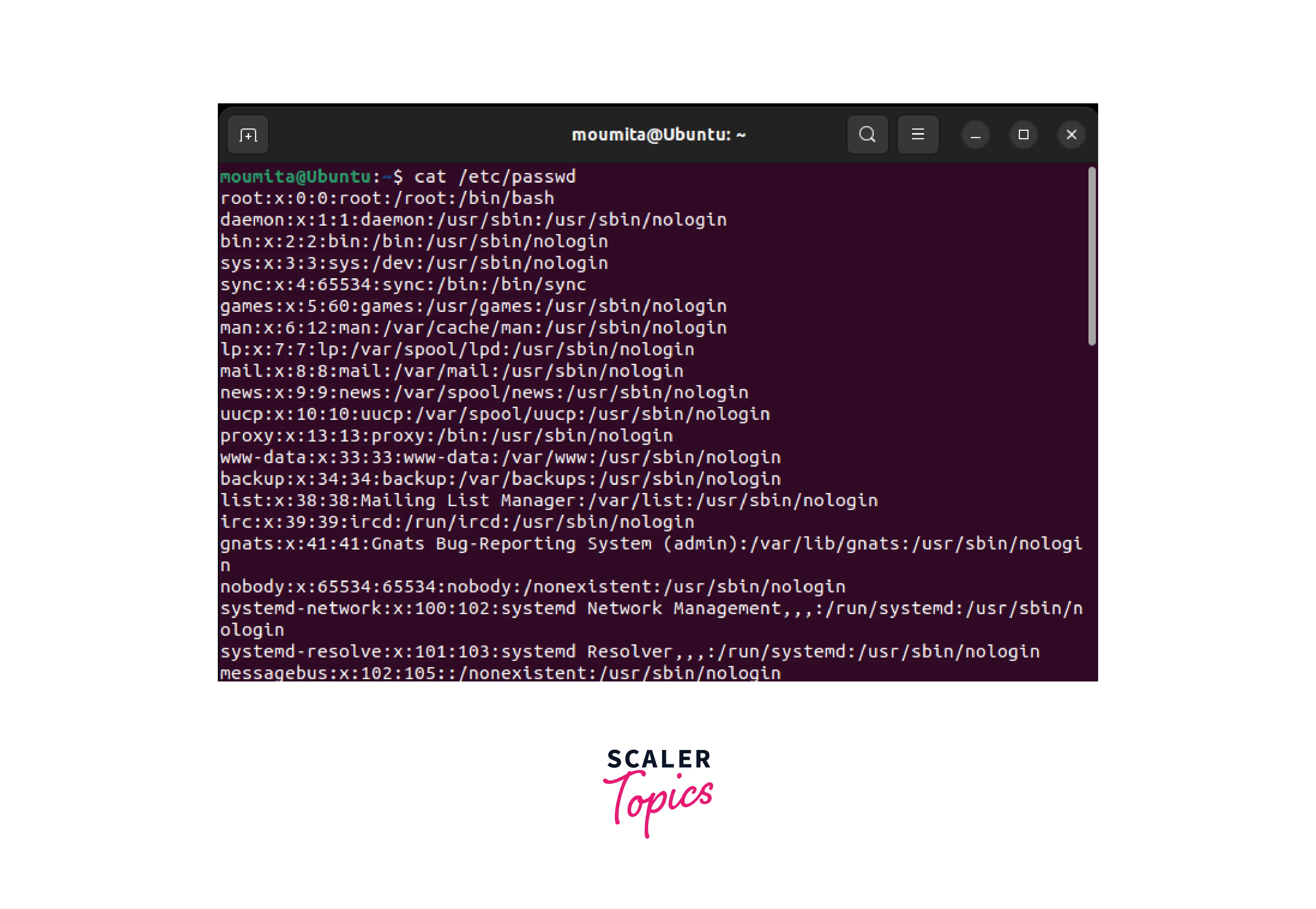
Step 3.: The cat command will display the entire contents of the /etc/passwd file in the terminal window.
Each line represents a user entry and contains several fields separated by colons (:). The fields typically include the username, password (represented by 'x'), user ID (UID), group ID (GID), user information, home directory, and default shell.
Extract user details:
To list only the usernames from the /etc/passwd file, you can use additional command line tools like awk or cut. For example, to extract and display only the usernames, you can modify the command as follows:

This command utilizes the awk command to extract the first field (username) from each line using the colon (:) delimiter.
Using More or Fewer Commands
The more and less commands are both used to view file contents one page at a time in the Linux command line interface. They provide an interactive way to browse through large files, including the /etc/passwd file, and navigate through the content in a paginated manner. These commands are particularly useful when dealing with lengthy files that do not fit entirely on a single screen.
Here are instructions on using the more or less commands to browse through the /etc/passwd file and list users in a paginated manner:
Execute the more command:
Step 1.: Launch the terminal application on your Linux system and Execute the more command as shown below.

This will display the contents of the /etc/passwd file, starting from the top. The file will be displayed one page at a time.
Step 2.: After executing the more command, you can use the following keys to navigate through the content:
- Press the Spacebar to view the next page.
- Press Enter to view the next line.
- Press the B key to go back one page.
- Press the Q key to quit and exit the "more" command, returning to the terminal prompt.
Execute the less command:
Step 3.: In the terminal, type the following command and press Enter:
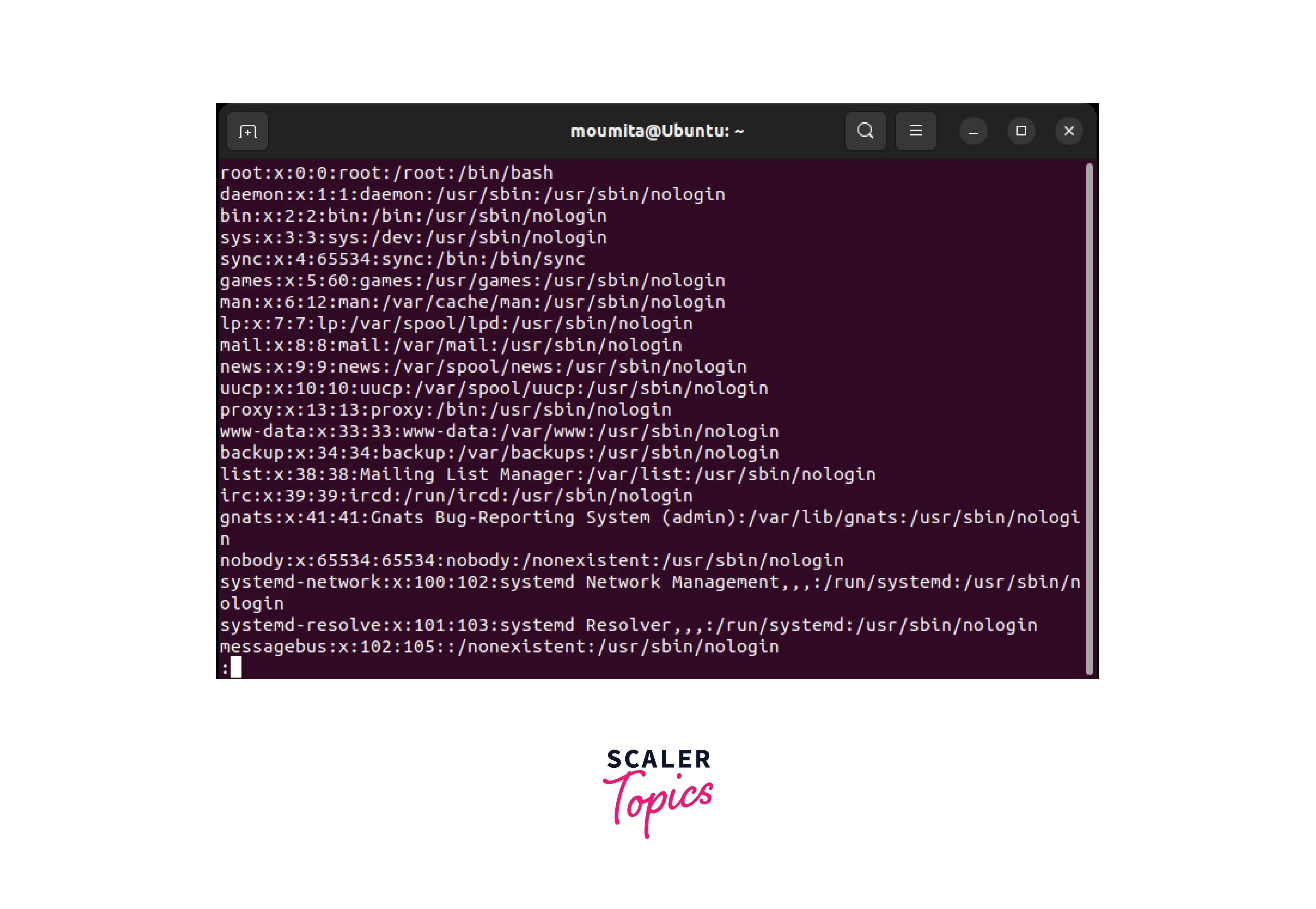
This will also display the contents of the /etc/passwd file in a paginated manner.
Step 4.: Similar to the more command, the less command provides navigation options as mentioned below.
- Press the Spacebar to view the next page.
- Press the Enter key to view the next line.
- Press the B key to go back one page.
- Press the G key to go to the end of the file.
- Press the / key to search for a specific term within the file.
- Press the Q key to quit and exit the "less" command.
Using awk Command
AWK is a powerful pattern-scanning and text-processing language that is commonly available on Linux systems. It provides a wide range of functionalities, including the ability to extract specific information from files and format it according to specific criteria. In the context of checking users in a Linux system, the AWK command can be utilized to extract and format user information from the /etc/passwd file.
Here we have explained how to utilize the AWK command to extract and format specific user information from the /etc/passwd file.
Launch the terminal application on your Linux system and execute the AWK command as mentioned below.

- The -F option specifies the field separator, which is set to a colon (:) in this case because the /etc/passwd file uses colons to separate fields.
- The {print $1} statement instructs AWK to print the first field (username) from each line of the /etc/passwd file.
The AWK command will extract and display the usernames from the /etc/passwd file in the terminal window. Each username will be listed on a separate line.
Customizing the output
The AWK command can be further customized to extract and format different fields from the /etc/passwd file. For example, to extract and display both the username and user ID (UID), you can modify the command as shown below.
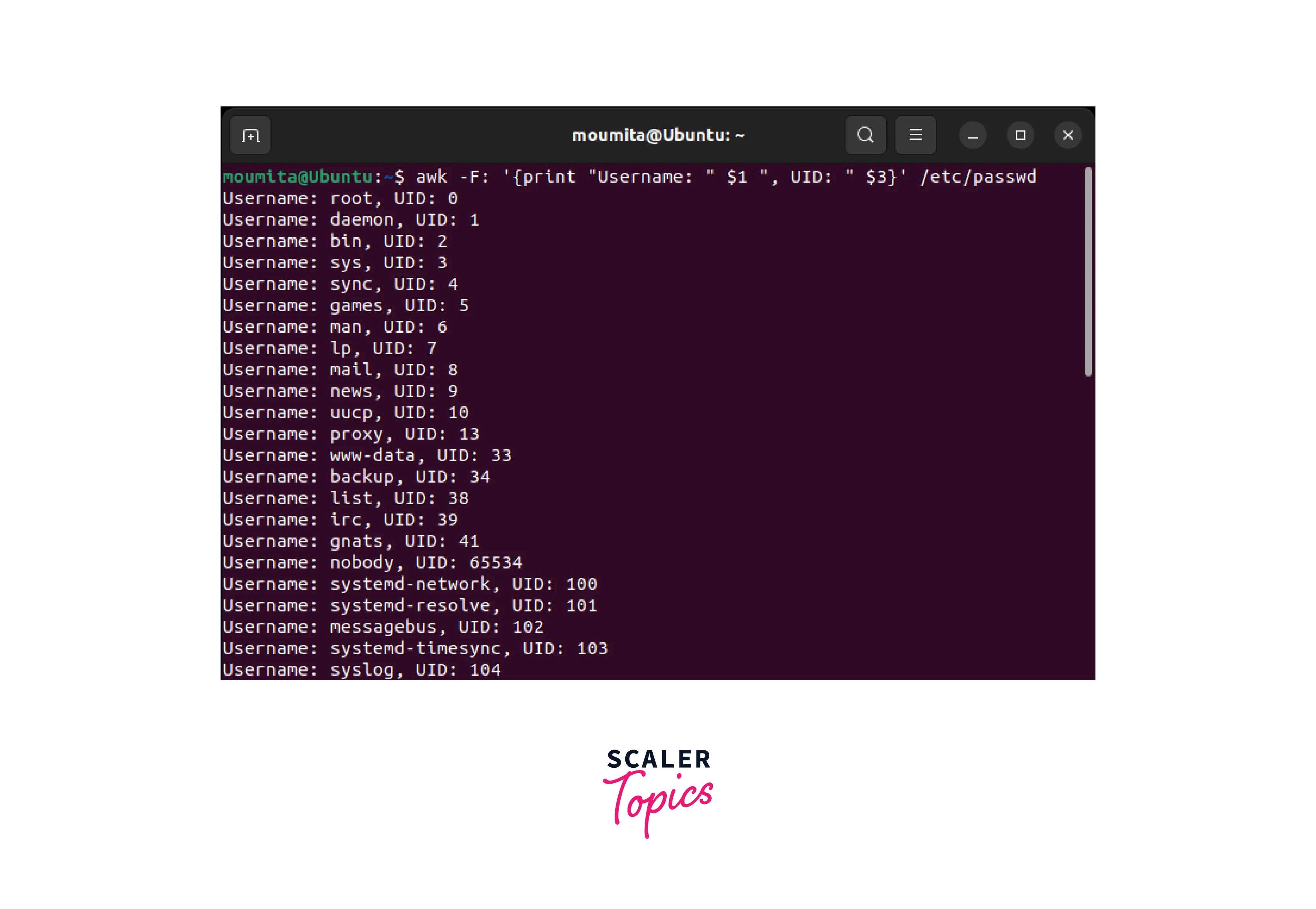
- The $3 represents the third field (UID) in the /etc/passwd file.
- The output will include both the username and UID, separated by commas and labeled accordingly.
Using get Command
The getent command is a powerful tool available in Linux systems that allows you to retrieve entries from various administrative databases, including the user database (passwd). It provides a convenient way to obtain user details and effectively list the users present on your Linux system.
Here we will be providing instructions on using the getent command to retrieve user entries from the password database.
Launch the terminal application on your Linux system and execute the getent command and type the command in the terminal as shown below and press Enter.
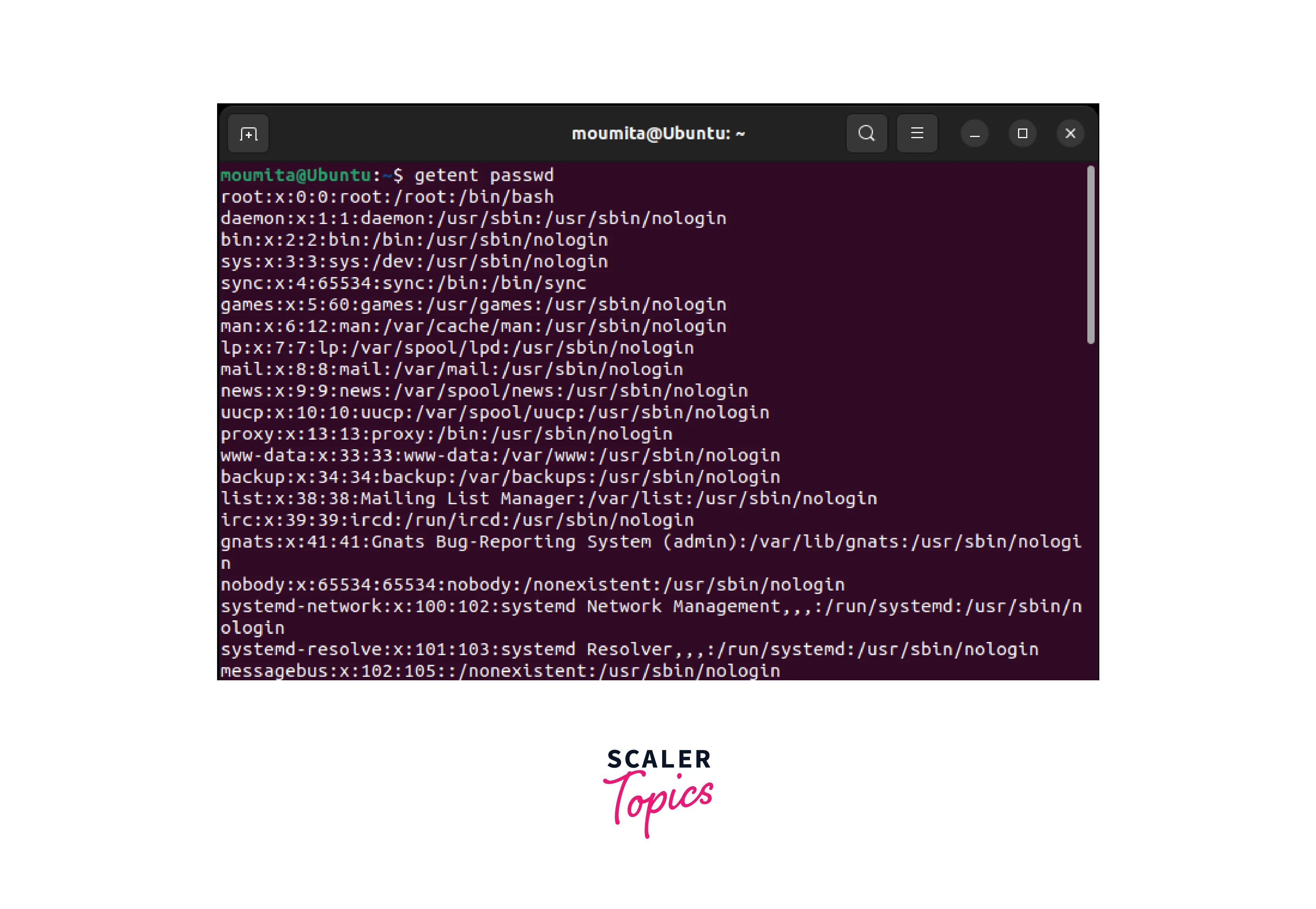
This command retrieves the user entries from the password database and displays them in the terminal.
View the output:
The getent command will output the user entries in a structured format. Each entry represents a user and contains several fields separated by colons (:). The fields typically include the username, password (represented by 'x'), user ID (UID), group ID (GID), user information, home directory, and default shell.
Customize the output:
The getent command can be customized to extract specific information or filter the output. For example, to list only the usernames, you can use additional command line tools like awk or cut. Here's an example using awk:
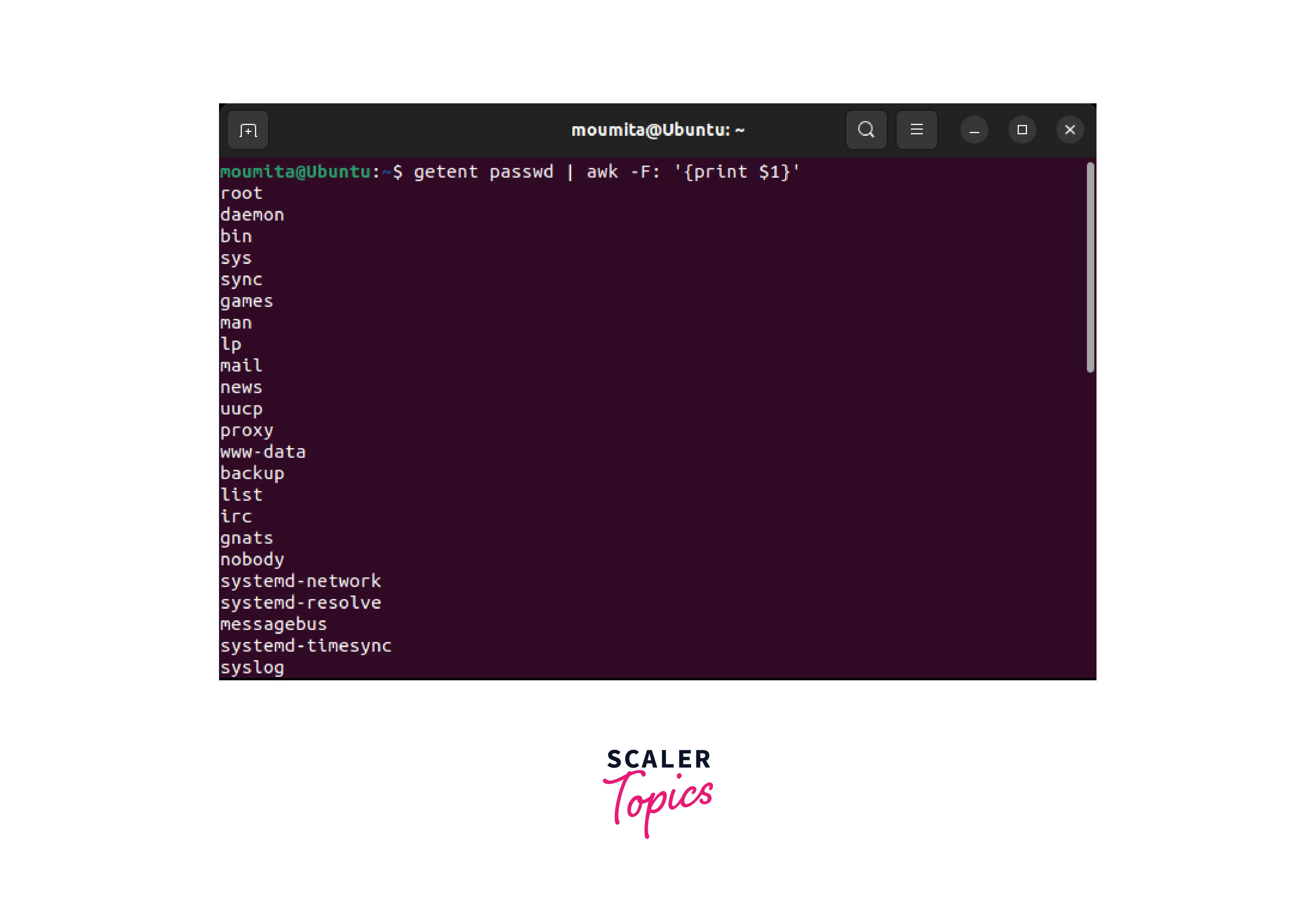
This command utilizes awk to extract and display only the usernames from the output of the getent command.
Filter by a specific user:
If you want to retrieve information for a specific user, you can specify the username as an argument to the getent command. As an example:
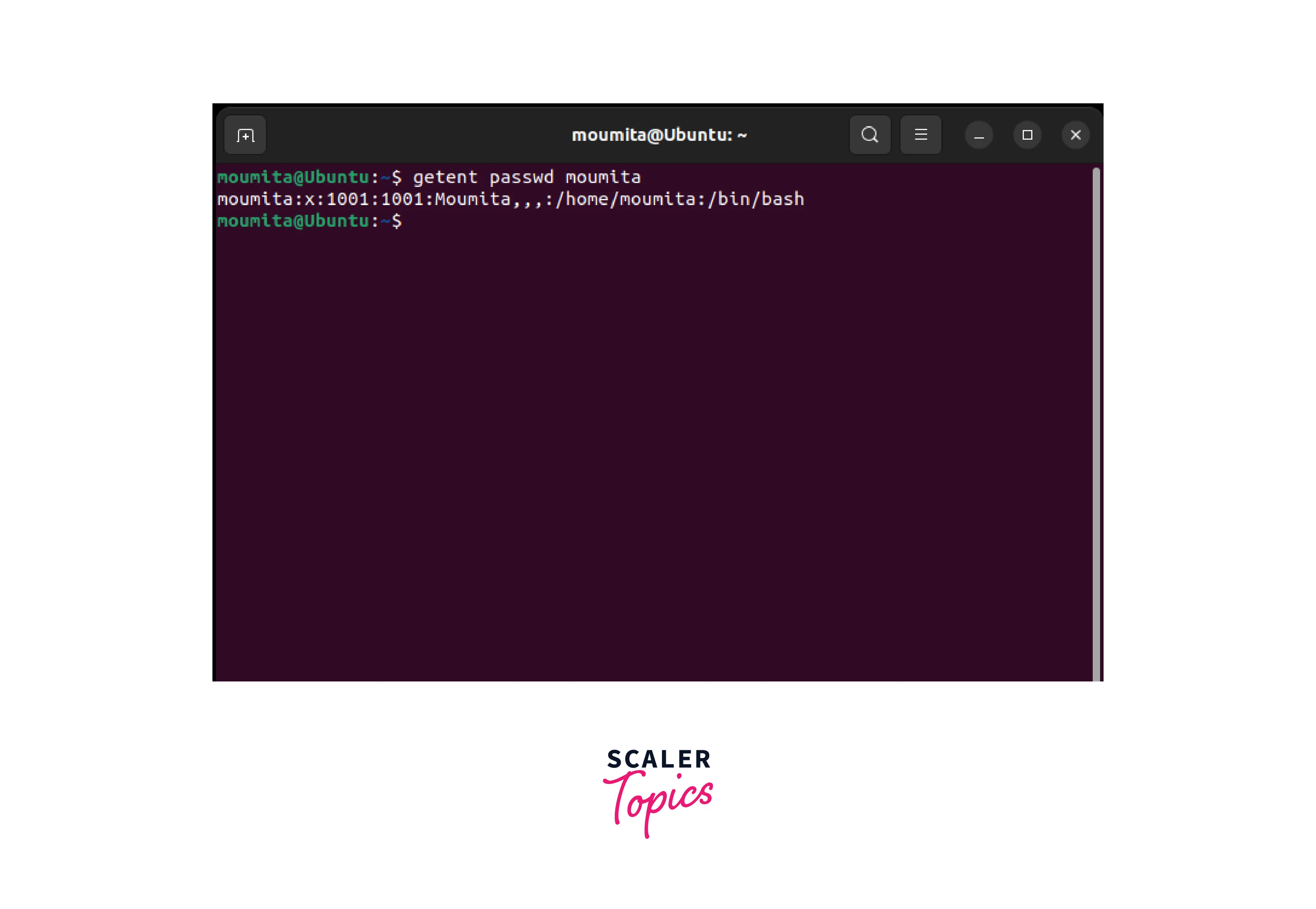
Replace <username> with the actual username you want to retrieve information for.
FAQs.
Q. How can I check the currently logged-in users in Linux?
A. To check the currently logged-in users in Linux, you can use the "who" command. Simply execute "who" in the terminal, and it will display a list of logged-in users along with their usernames, terminal devices, login time, and originating IP address.
Q. How can I find a specific user's information in Linux?
A. To find a specific user's information in Linux, you can use the "grep" command along with the "cat" command to search for the user's entry in the /etc/passwd file. For example, to find information about the user "john", you can execute the following command: "cat /etc/passwd | grep john". This will display the entry for the user "john" and provide details such as the username, UID, GID, home directory, and default shell.
Conclusion
-
Checking users in a Linux system is an essential task for system administrators and users alike.
-
By utilizing various methods, it becomes easier to gather user information and ensure proper user management.
-
cat, more, and less commands for viewing the /etc/passwd file and browsing user information.
-
AWK command for extracting and formatting specific user details from the /etc/passwd file.
-
getent command for retrieving user information from administrative databases.
-
Each method offers advantages and flexibility, allowing you to obtain user information based on your specific requirements.
-
Understanding the users on your Linux system helps ensure proper access control, user privilege management, and overall system security.
